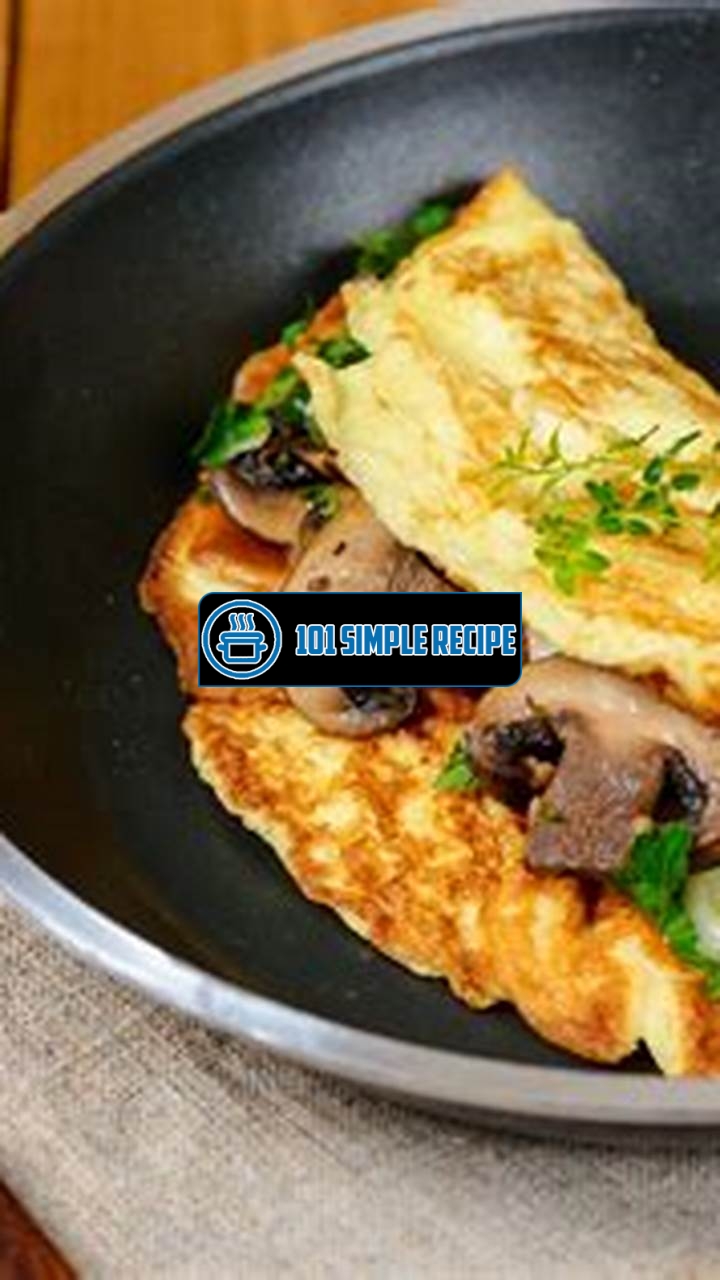Are you tired of eating the same old scrambled eggs every morning? Why not switch things up and try preparing a perfect omelette with this easy recipe? Making a delicious omelette doesn’t have to be complicated or time-consuming. With a few simple ingredients and some basic cooking techniques, you can whip up a flavorful and satisfying meal in no time. Whether you’re a beginner in the kitchen or an experienced home cook, this recipe will guide you through the process step by step to ensure a perfect omelette every time. So put on your apron, grab a whisk, and let’s get cooking!

Understanding the Art of Making an Omelette
Are you ready to embark on a journey to become a master omelette chef? In this article, we will share with you the secrets to creating the perfect omelette and unlock your culinary potential. So, put on your apron and let’s get cracking!
Making an omelette is not just about mixing eggs and ingredients together. It is an art that requires precision, technique, and a touch of creativity. To achieve the perfect omelette, you need to have a deep understanding of the process and the ingredients involved.
Before we dive into the nitty-gritty of making an omelette, let’s first understand the basic concept. An omelette is a dish made from beaten eggs cooked with various fillings and often served folded in half. It is a versatile dish that can be enjoyed for breakfast, lunch, or dinner.
Now, let’s move on to the step-by-step guide on making the perfect omelette.
Making the Perfect Omelette: A Step-by-Step Guide
Step 1: Prep and Beat the Eggs
First, gather all the necessary ingredients: eggs, fillings (such as cheese, vegetables, or meats), and seasonings. Crack the eggs into a bowl and beat them until the yolks and whites are well-incorporated. This step ensures a fluffy and uniform texture for your omelette.
Step 2: Heat the Pan and Add the Eggs
Next, heat a non-stick pan over medium heat. Add a knob of butter or a drizzle of oil to the pan and let it melt. Swirl the pan to coat the bottom evenly. Pour the beaten eggs into the pan, ensuring they spread out to form an even layer.
Step 3: Add Fillings and Seasonings
Once the eggs start to set, it’s time to add your desired fillings. Whether you prefer classic combinations like ham and cheese or more adventurous flavors like spinach and feta, the choice is yours. Sprinkle your fillings evenly over one half of the omelette. Don’t forget to season with salt, pepper, or herbs for added flavor.
Step 4: Fold and Cook
Using a spatula, gently fold the empty side of the omelette over the fillings. Press lightly to seal the omelette. Continue cooking for a few more minutes until the fillings are heated through and the omelette is cooked to your desired level of doneness. For a runny omelette, cook for a shorter time. For a firmer omelette, cook for a bit longer.
Choosing the Right Ingredients for Your Omelette
When it comes to creating the perfect omelette, the choice of ingredients plays a crucial role. Opt for fresh, high-quality eggs from a trusted source. Look for fillings that complement each other and add a burst of flavor to your omelette. Consider ingredients like cheese, mushrooms, onions, peppers, or even leftover cooked meats like chicken or bacon.
Remember, the key to a delicious omelette lies in the balance of flavors and textures. Don’t be afraid to experiment with different combinations to find your personal favorite.
Mastering Different Omelette Flavors and Variations
Now that you’ve mastered the art of making a basic omelette, it’s time to take your culinary skills to the next level. There are countless variations and flavor profiles you can explore to create a truly unique omelette.
For instance, if you’re a fan of Mediterranean flavors, try adding sun-dried tomatoes, olives, and feta cheese to your omelette. If you prefer a spicy kick, experiment with jalapenos, hot sauce, or chili flakes. The possibilities are endless, and it all depends on your taste preferences and creativity.
In conclusion, mastering the art of making an omelette requires practice, patience, and a willingness to experiment. By following the step-by-step guide and choosing the right ingredients, you’ll be able to create a perfect omelette every time. So, put your skills to the test and enjoy the satisfaction of serving up a delicious omelette that will impress your friends and family.
For a twist on the classic omelette, try our recipe for a loaded omelette packed with delicious fillings like cheese, veggies, and bacon.
Essential Tools and Equipment for Omelette Making
Equip yourself with the necessary tools and equipment to enhance your omelette making experience.
The Must-Have Utensils for Omelette Making
When it comes to making the perfect omelette, having the right utensils is essential. These tools not only make the cooking process easier but also contribute to the overall taste and presentation of your omelette. Here are some must-have utensils for omelette making:
- Egg Whisk: This tool allows you to beat the eggs thoroughly and create a light and fluffy texture.
- Non-Stick Pan: A non-stick pan is vital for ensuring that your omelette doesn’t stick to the surface and makes flipping it effortless.
- Spatula: A spatula helps you flip and fold your omelette without breaking it apart.
- Bowl: Having a mixing bowl handy allows you to whisk your eggs and add any additional ingredients before cooking.
- Knife: A sharp knife is essential for chopping ingredients like vegetables, herbs, or cheese that you may want to include in your omelette.
Note: Investing in quality utensils will ensure better results and durability in the long run. Don’t skimp on these essential tools!
Exploring Different Types of Omelette Pans and Skillets
Now that you have the basic utensils, it’s time to choose the right pan or skillet for your omelette. Here are a few popular options:
| Type of Pan/Skillet | Description |
|---|---|
| Traditional Non-Stick Pan | A classic choice, these pans have a non-stick coating that ensures easy flipping and cleaning. |
| Cast Iron Skillet | Known for its excellent heat retention, a cast iron skillet provides even cooking and can be used both on the stovetop and in the oven. |
| Induction-Safe Pan | If you have an induction cooktop, make sure to choose a pan that is specifically designed for induction cooking. |
Consider your specific needs and preferences when selecting the right pan or skillet. Each option has its own advantages, so choose one that suits your cooking style and equipment.
Additional Kitchen Gadgets That Can Elevate Your Omelette Game
While the basic tools and pans are essential, there are also some additional kitchen gadgets that can take your omelette making to the next level. Here are a few to consider:
- Egg Separator: This handy gadget helps you separate the egg yolk from the whites easily, ensuring a pristine omelette.
- Omelette Turner: Specifically designed for omelette flipping, this tool helps you achieve a perfectly folded and intact omelette.
- Electric Whisk: If you prefer an easier and quicker way to whisk your eggs, an electric whisk can save you time and effort.
- Omelette Maker: For those who are new to omelette making or want a foolproof option, an omelette maker can simplify the process with its built-in features.
While these gadgets are not essential, they can be fun additions to your kitchen and make omelette making even more enjoyable.
By equipping yourself with the essential tools, choosing the right pan, and considering additional gadgets, you’ll be well-prepared to create the perfect omelette every time. Happy cooking!
Tips and Techniques for a Flawless Omelette
Creating a flawless omelette may seem like a daunting task, but with the right tips and techniques, you can master this art. Whether you’re a beginner or a seasoned cook, these valuable insights will guide you towards making the perfect omelette every time.
Whisking Eggs to Perfection: The Key to Fluffy Omelettes
Whisking the eggs properly is the first step towards achieving a fluffy omelette. To ensure your eggs are whisked to perfection, follow these techniques:
- Room temperature eggs: Start with eggs that are at room temperature. Cold eggs can result in a rubbery texture.
- Air incorporation: Whisk the eggs vigorously to incorporate air. This will make your omelette light and fluffy.
- A pinch of salt: Add a pinch of salt to the eggs before whisking. The salt helps break down the proteins in the eggs, resulting in a smoother texture.
- Consistent whisking: Whisk the eggs consistently in a circular motion until the yolks and whites are fully combined.
By following these simple techniques, your omelette will have a light and airy texture, making it a delight to eat. ️
The Art of Flipping: Mastering the Perfect Omelette Flip
Flipping an omelette can be a tricky maneuver, but with practice and the right techniques, you can become a pro. Here’s how:
- A non-stick pan: Start with a non-stick pan to ensure that your omelette flips easily without sticking to the surface.
- Proper heat: Heat your pan over medium-high heat before adding the whisked eggs. This will ensure even cooking and make flipping easier.
- Using a spatula: Gently slide a spatula around the edges of the omelette to loosen it from the pan. Then, swiftly flip the omelette using the spatula and your wrist to complete the flip.
- Practice makes perfect: Don’t be discouraged if your first few flips don’t go smoothly. The more you practice, the better you’ll become at achieving the perfect flip every time.
With these techniques, you’ll soon be flipping omelettes like a pro, impressing your family and friends with your culinary skills. ✨
Experimenting with Fillings and Toppings for Extra Flavor
Once you have mastered the basic omelette techniques, it’s time to get creative with your fillings and toppings. Here are some ideas to enhance the flavor of your omelette:
- Cheese: Experiment with different types of cheese like cheddar, feta, or goat cheese. The cheese will melt and add a creamy and savory element to your omelette.
- Vegetables: Add sautéed vegetables such as bell peppers, mushrooms, onions, or spinach for a burst of flavor and added nutrients.
- Meats: For a heartier omelette, include cooked bacon, ham, or sausage to complement the eggs.
- Herbs and spices: Sprinkle fresh herbs like parsley, chives, or basil, as well as spices like paprika or cayenne pepper, to add depth and complexity to your omelette.
Don’t be afraid to mix and match different fillings and toppings to create your own unique omelette recipes. The possibilities are endless, and you can discover flavor combinations that you truly love.
By following these tips and techniques, you will be well on your way to creating a flawless omelette every time. Remember, practice makes perfect, so don’t be discouraged if your first attempts are not as successful as you’d hoped. With time and experience, you’ll become a master at making delicious, fluffy, and flavorful omelettes. Happy cooking!
If you’re looking for more delicious recipes, check out our omelette recipes for inspiration to elevate your breakfast game.
Health Considerations for Omelette Enthusiasts
Discover how to make healthier choices when preparing omelettes without sacrificing flavor.
Opting for Nutritious Alternatives to Traditional Fillings
When it comes to omelette fillings, you have the freedom to choose from a wide range of ingredients. Instead of sticking to the traditional options like cheese, bacon, and ham, consider incorporating more nutritious alternatives.
One excellent choice is adding vegetables such as spinach, mushrooms, bell peppers, and onions as fillings. These options not only provide essential vitamins and minerals but also add a delightful crunch and flavor to your omelette. You can experiment with different vegetable combinations to find your favorite. ️
Another healthy alternative is using lean proteins like turkey or chicken instead of fatty meats. These lean options reduce the overall fat content of your omelette while still giving you a satisfying protein boost. You can also explore plant-based protein options like tofu or tempeh for a vegetarian or vegan-friendly omelette.
Incorporating whole grains into your omelette is another way to boost its nutritional value. Instead of using plain white bread, consider using whole wheat or multigrain bread when making toast to accompany your omelette. This simple switch adds fiber and complex carbohydrates to your meal, keeping you fuller for longer and providing sustained energy throughout the day.
Remember, the key to a healthy omelette is to include a balance of proteins, vegetables, and whole grains. By opting for nutritious alternatives to traditional fillings, you can make your omelette not only delicious but also packed with essential nutrients.
Reducing Fat and Calories in Your Omelette Preparations
If you’re looking to reduce the fat and calorie content of your omelette, there are several simple yet effective strategies you can employ.
Firstly, consider using cooking spray or a non-stick pan instead of butter or oil when preparing your omelette. This significantly reduces the amount of added fat while still preventing your omelette from sticking to the pan.
Additionally, you can choose to use low-fat ingredients or smaller portions of high-fat ingredients. For example, opting for low-fat cheese or using only a sprinkle of full-fat cheese can still provide the desired creaminess without adding excessive calories. Similarly, using fewer egg yolks and more egg whites helps reduce the fat content while maintaining the protein content of your omelette.
Another way to cut back on fat and calories is by choosing healthier cooking methods. Instead of frying your omelette, try baking or broiling it. These techniques require less added fat and still result in a delicious and fluffy omelette.
Lastly, be mindful of the toppings and condiments you choose to accompany your omelette. Opt for fresh herbs, salsa, or hot sauce instead of high-calorie sauces like mayonnaise or hollandaise. These flavorful alternatives add excitement to your omelette without piling on extra calories and unhealthy fats. ️
Exploring Dietary Restrictions and Allergy-Friendly Omelette Options
If you have specific dietary restrictions or allergies, you can still enjoy a tasty omelette by making a few adjustments to the recipe.
For those following a gluten-free diet, ensure that your omelette fillings and seasonings are free from gluten-containing ingredients. Naturally gluten-free options like vegetables, meats, and herbs are safe to use. Additionally, you can find gluten-free bread or wrap alternatives to enjoy with your omelette.
If you’re lactose intolerant or following a vegan diet, there are numerous dairy-free alternatives available, such as plant-based milk, vegan cheese, and tofu-based fillings. These options still provide the creamy texture and flavor without the use of dairy.
For individuals with egg allergies or those following a vegan diet, there are egg substitutes available that can be used in omelette recipes. These substitutes are typically made from chickpea flour or other plant-based ingredients and mimic the texture and taste of eggs.
Always remember to read ingredient labels carefully to avoid any potential allergens and ensure the safety of your omelette. With a little creativity and exploration, you can prepare an omelette that fits your dietary needs while still being delicious.✅ ️
Troubleshooting Tips for Omelette Mishaps
When it comes to making omelettes, even experienced cooks can encounter some common mishaps. Fear not! We have some helpful tips to troubleshoot these common mistakes and challenges, ensuring your omelettes turn out perfect every time. Whether you’ve overcooked or burnt your omelette, it’s sticking to the pan, or the filling is spilling and tearing, we’ve got solutions to rescue your breakfast masterpiece.
Rescuing an Overcooked or Burnt Omelette
We’ve all been there – got distracted, and before you know it, your omelette is overcooked or burnt. But don’t despair! You can salvage it with a couple of simple steps.
1. Lower the heat: If you notice your omelette is cooking too quickly or becoming too brown, reduce the heat immediately. This will slow down the cooking process and prevent any further damage.
2. Add moisture: Overcooked omelettes tend to dry out. To add moisture back into the dish, sprinkle a few drops of water or broth over the omelette. You can also opt for a light drizzle of melted butter or oil, which will help to revitalize the texture.
3. Flip it: If only one side of your omelette is overcooked, carefully flip it using a spatula. Cook the other side for a shorter duration until it reaches the desired consistency.
Fixing Omelettes that Stick to the Pan
Is your omelette stubbornly sticking to the pan, leaving you with a messy scramble instead? Here are a few tips to avoid this sticky situation:
1. Non-stick pan: Investing in a good-quality non-stick pan is essential for hassle-free omelette making. The non-stick surface ensures easy release, preventing your omelette from sticking and tearing apart.
2. Preheat the pan: Before adding any ingredients, make sure your pan is properly preheated. Heat the pan over medium heat for a few minutes, allowing it to reach the desired temperature. This will create a slick surface, minimizing the chances of sticking.
3. Use enough fat: Adding a small amount of fat, such as butter or cooking oil, to the pan before pouring the beaten eggs can further reduce the risk of sticking. As the fat spreads across the surface, it creates a barrier between the eggs and the pan.
Dealing with Omelette Filling Spills and Tears
Nothing is more disappointing than omelette filling spilling out or tears appearing while cooking. Here’s how to tackle these issues:
1. Less is more: Be mindful of the amount of filling you add to your omelette. Overfilling can lead to spills and tears. Aim for a moderate amount of filling that will evenly distribute throughout the omelette without overflowing.
2. Proper folding technique: Mastering the art of folding your omelette is crucial. Gently lift one side and fold it over the filling, then carefully flip the other side on top. Use a spatula to press down the edges, ensuring the filling stays securely inside.
3. Be patient: Avoid rushing the cooking process, as this can cause the omelette to tear. Cook the omelette over medium-low heat, allowing it to set slowly. Patience is key to a flawless, tear-free omelette.
By following these troubleshooting tips, you’ll be well-equipped to handle any omelette mishaps that come your way. With a little practice, you’ll soon be flipping out perfect omelettes every time!
Remember, a well-executed omelette not only satisfies your taste buds but also showcases your culinary prowess. So, get cracking and enjoy your delicious homemade omelettes.
In our article on choosing the right cookware for omelettes, you’ll find helpful tips and recommendations to create the perfect omelette every time.
Frequently Asked Questions
Below are some frequently asked questions about making a delicious omelette:
| No. | Questions | Answers |
|---|---|---|
| 1. | Can I use milk instead of cream in an omelette? | Yes, you can substitute milk for cream in an omelette. It will make it lighter and fluffier. |
| 2. | How do I prevent my omelette from sticking to the pan? | To prevent sticking, make sure to properly grease your pan with butter or oil before adding the eggs. |
| 3. | Can I add vegetables to my omelette? | Absolutely! Adding vegetables such as bell peppers, onions, and mushrooms can add a delicious and nutritious twist to your omelette. |
| 4. | What is the best cheese to use in an omelette? | The best cheese for an omelette is subjective, but popular choices include cheddar, Swiss, and feta. |
| 5. | Can I make an omelette without flipping it? | Absolutely! You can fold the omelette in half instead of flipping it for a simpler cooking process. |
| 6. | How do I know when my omelette is fully cooked? | A fully cooked omelette should have a firm texture and the eggs should no longer be runny. You can use a spatula to gently lift the edges to check. |
Thank You for Reading!
We hope that this article has provided you with useful tips and techniques to make a delicious omelette. Whether you’re a beginner or an experienced cook, perfecting the art of the omelette is a satisfying skill to have. Remember to experiment with different fillings and flavors to create personalized omelettes that suit your taste. Stay tuned for more exciting recipes and culinary adventures. Happy cooking and enjoy your next omelette! Don’t forget to visit our website again for more great recipes and cooking inspiration.
Jump to Recipe
How to Make an Omelette Recipe

Learn how to make a fluffy and delicious omelette with this easy recipe. Perfect for breakfast, brunch, or even dinner!
- 2 large eggs
- 1 tablespoon butter
- Salt and pepper (to taste)
- Your choice of fillings (e.g. cheese, vegetables, ham)
- Crack the eggs into a bowl and whisk them until well beaten.
- Heat a non-stick pan over medium heat and melt the butter.
- Pour the beaten eggs into the pan, tilting it to spread the eggs evenly.
- Let the eggs cook undisturbed for a minute or until the edges start to set.
- Gently lift the edges of the omelette with a spatula and tilt the pan to let any uncooked eggs flow to the edges.
- Once the omelette is mostly set but still slightly runny on top, sprinkle your desired fillings on one half of the omelette.
- Fold the other half of the omelette over the fillings and press gently with the spatula to seal.
- Cook for another minute or until the cheese is melted and the omelette is cooked to your desired doneness.
- Slide the omelette onto a plate and season with salt and pepper. Serve hot and enjoy!






